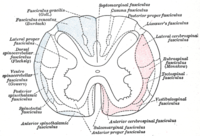
Photo from wikipedia
Purpose: The study aimed to analyze the clinical characteristics, laboratory test results, neuroimaging findings, and outcomes in patients diagnosed with subacute combined degeneration (SCD). Materials and Methods: A total of… Click to show full abstract
Purpose: The study aimed to analyze the clinical characteristics, laboratory test results, neuroimaging findings, and outcomes in patients diagnosed with subacute combined degeneration (SCD). Materials and Methods: A total of 68 patients with SCD who had been appropriately treated for no less than 6 months were included in our study. Histories, results of routine blood tests, biochemical indices, serum vitamin B12 levels, and spinal magnetic resonance imaging (MRI) findings from the patients were studied and analyzed. Clinical signs and symptoms, graded using a functional disability rating scale, were scored at the time of admission and 3 and 6 months after admission. Results: Limb numbness, limb weakness, and gait disturbances were the most common symptoms in patients with SCD. All patients showed clinical improvement to different degrees at the follow-up visits after vitamin B12 treatment. No differences in rating score were found in patients grouped by sex, hemoglobin level, serum vitamin B12, or MRI manifestations at the time of admission or at the follow-up visits. Younger patients and those with shorter disease courses had better rating scores at the short-term follow-up visits. Conclusion: Anemia, low levels of serum vitamin B12, and MRI abnormalities in the spinal cord are not expected to be associated with worse clinical manifestations. The age of onset and course of disease are important in evaluating the short-term prognosis of patients with SCD.
Journal Title: European Neurology
Year Published: 2018
Link to full text (if available)
Share on Social Media: Sign Up to like & get
recommendations!